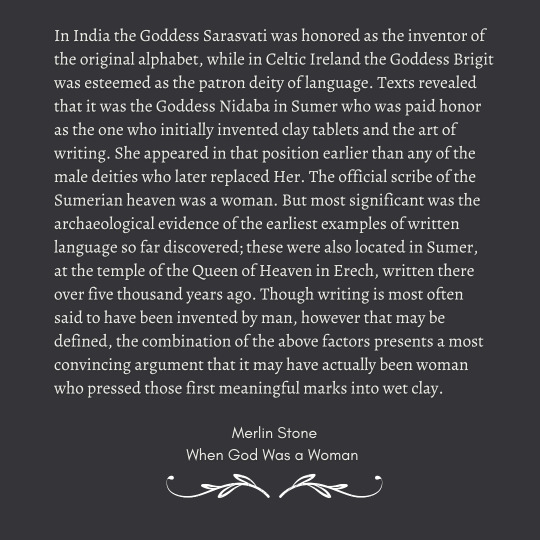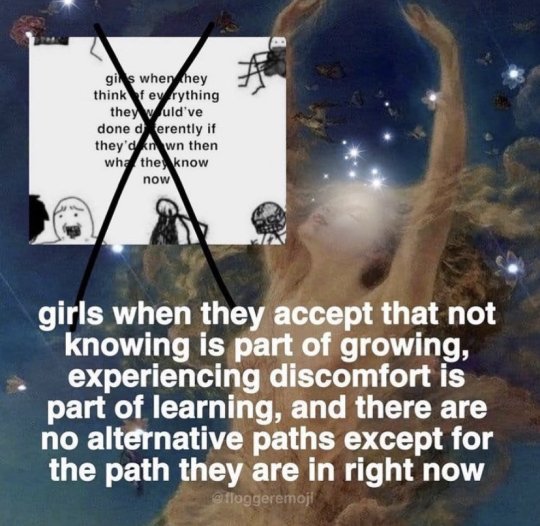Don't wanna be here? Send us removal request.
Text
Don’t be afraid to view the wild, dark and dangerous parts of being a woman.
To truly be a witch in her power, is to own all of yourself.
Don’t be afraid to bare your teeth and get your knuckles bloody.
282 notes
·
View notes
Text
“There is no historically consistent justification for the exclusion of women from healing roles. Witches were attacked for being pragmatic, empirical, and immoral. But in the nineteenth century the rhetoric reversed: women became too unscientific, delicate, and sentimental. The stereotypes change to suit male convenience—we don’t, and there is nothing in our “innate feminine nature” to justify our present subservience.”
— Barbara Ehrenreich & Deirdre English, Witches, Midwives, and Nurses: A History of Women Healers
597 notes
·
View notes
Text
“I, like thee, was instructed when young by priests to worship an invisible god. But an old woman in whom I had great confidence once said to me, ‘Why worship a deity whom you cannot see, when there is the Moon in all her splendour visible? Worship her. Invoke Diana, the goddess of the Moon, and she will grant your prayers.’ This shalt thou do, obeying the Vangelo, the Gospel of (theWitches and of) Diana, who is Queen of the Fairies and of the Moon.”
— The House of the Wind: Aradia, Gospel of the Witches (via visardistofelphame)
664 notes
·
View notes
Text
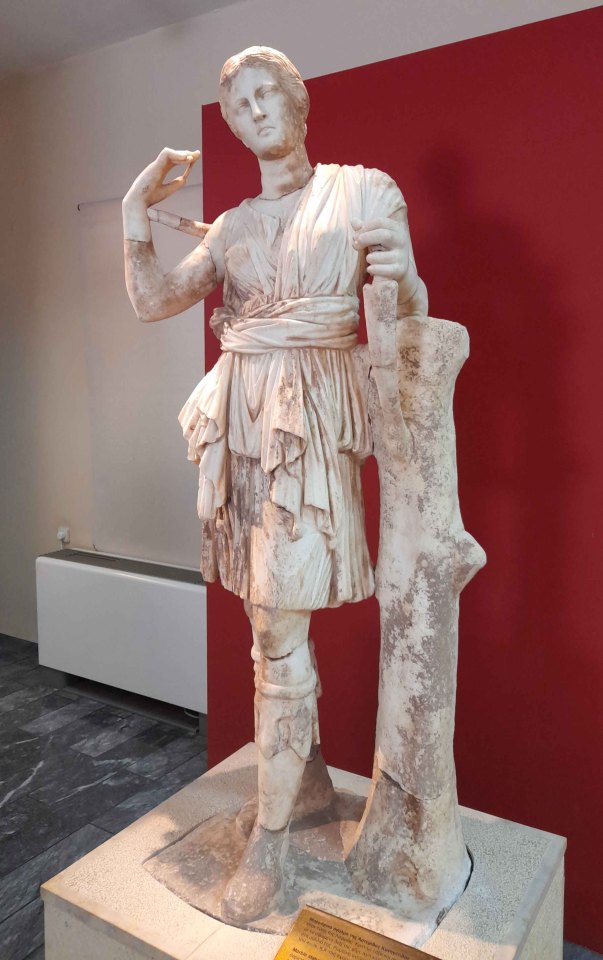
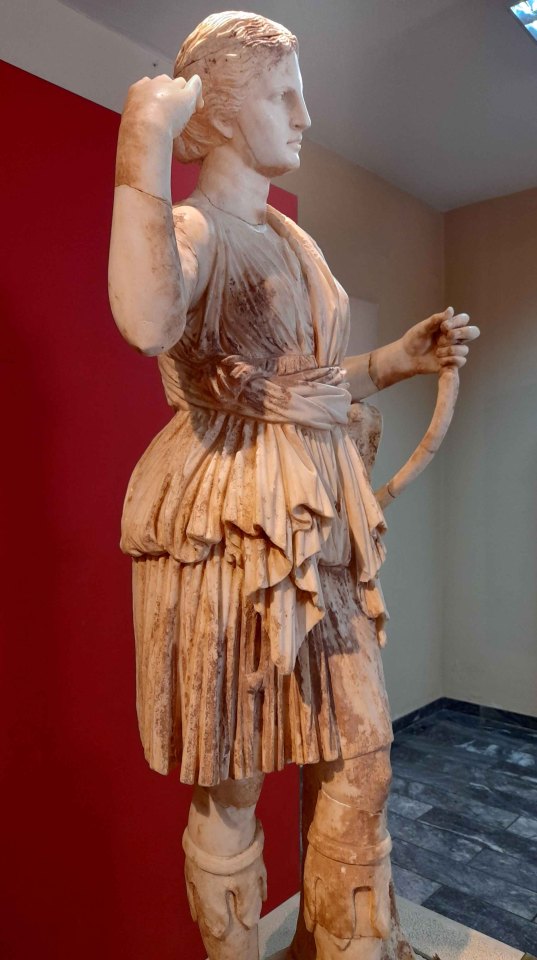

Artemis statue from the archeological museum of Messini, Greece.
560 notes
·
View notes
Text
Female-only faith spaces and traditions are important and neccessary for the spiritual health of women worldwide and it breaks my heart that so many people seem to be against them. Women are not "bigots" for wanting to worship in female only spaces.
881 notes
·
View notes
Photo

GODDESS WORSHIP IN ANCIENT MECCA
Prior to Muslim conquest in 631, Arabs worshipped goddesses. Instead of imams, they had priestesses. Matriarchal religion was nature-based and associated with astronomy, trees, mountains, and rocks.
Depicted is an ancient priestess of the Arab sun goddess, Shams. Worshippers made pilgrimages to Mecca in Saudi Arabia and circled the Kaaba naked. The Kaaba was addressed using a feminine grammatical form and contained paintings and 360 sculptures that probably represented the days of the year. The Kaaba was thought to be the center of the world, directly below heaven. Its embedded black stone was a symbol of a meteorite.
The Sabaeans had seven temples dedicated to the seven planets and worshipped the stars and made a pilgrimage to Mecca each lunar year. Bedouins made the same pilgrimage.
Sadly all goddess-related art was raided and destroyed by Muhammad’s followers and Mecca surrendered and was forced to worship Allah around 631, although goddess worship was still practiced throughout the Arabian Peninsula and beyond.
256 notes
·
View notes
Text
Ancestral offerings
Bread
“In Western cultures, bread is strongly associated with life. It has formed the backbone of many diets, particularly for the middle and lower classes, since we first discovered how to make it. Wheat flour and water mixed together can only sustain a human being for a while. Eventually that person will die of malnutrition unless they eat something else. But if you allow that same flour and water a moment alone, something miraculous happens: natural contaminants in the flour act as yeast and ferment it, causing the dough to rise. Once baked into bread, the result can sustain human life indefinitely. For this reason, the first human cities developed when we had the means to reliably cultivate and store grain. Also for this reason, the socioeconomic factor most closely linked to political unrest and revolution is the price of bread.
Our intimate relationship with bread is reflected in the ancient cult of Demeter and even modern Christianity, whose central ritual is the consumption of the flesh of God in the form of bread. When you offer bread to your ancestors, you are offering something that the last 30,000 years of your ancestral line likely ate every day and associated with life and divinity. It is the modern food that the largest segment of your ancestral line knew in their earthly lives, making it an excellent offering when you wish to reach those older generations.
Coffee and Tea
Coffee and tea are both stimulants. They can be offered to your ancestors to “wake them up” when you need them to get working, especially if you need them to intervene quickly. If there’s a problem in your life that you would like to bring their attention to, you may wish to give them a cup of coffee or tea while making your petition.
Sweets
Sweets come at the end of a meal on special occasions. Likewise, we may offer them to our ancestors as a sign of special thanks after some favor is received. (Compare with coffee and tea, which are served when that favor is needed!) Alternatively, you may wish to offer sweets when you need to sweeten someone, that is, when you need them to favor you: for example, when you want a new job or promotion.”
Honoring your Ancestors by Mallorie Vaudoise
775 notes
·
View notes
Text
New devotional art project!
One part adhd, two parts extra craft supplies. Stir in a heaping tablespoon of devotion and add a jean jacket!

My wife and I recently moved and whoop I have too many art supplies. Bits and bobs from prior projects or just a case of beads because one time for my birthday my wife went to Michael's and brought back $70 of them during a 50% sale lol. I've always wanted a Jean jacket to muck around with and now I've got the chance. The lace has been added to the front and now I've got to paint the back white so I can start on some mural...I haven't put it all together yet in my brain but it's forming.

To me the lace kinda looks like little owls, let me know if you can see it.
22 notes
·
View notes
Text
Witchy things to do with your ash

Put it above your door: If your ash comes from incense or an herb bundle, the ash shares the same correspondences and power as the herb. I’ve met some who think it’s even stronger, as it’s been activated. You can either use the bundle to make a light mark above a door frame or it can be done with a finger. This can be powerful protection, luck bringing, or love inducing, depending on your intent and correspondence
Use it in spells: Why get rid of something so powerful? As mentioned, the ash still has power and energy. Your correspondence is based on what was burned. You can use it in place of that herb if you’re out, or in addition.
Use it in anointing: While it’s often used in conjunction with oil, ash has a long history of being used in anointing. Burning holy herbs, and then using a finger to swipe cooled ash onto someone being anointed is a powerful piece of the ceremony
Bury it: A lot of witches, including myself, find that burying the remnants of a spell is incredibly powerful. It’s often seen as giving respect to the earth for the power it gives. The phrase ashes to ashes, dust to dust comes to mind. It’s essentially the ending of a spell, returning the ash to the earth
Ward your home: Sprinkling protective herbs and ash around the perimeter of your home can help ward against negative energy and evil spirits.
Mix it in to art: Did you know you can make your art magic? Through sigils, colors, intention and more. But one possibility is to mix a bit of ash into your paints or use it as a charcoal substitute
3K notes
·
View notes
Text
“Through the violent imposition and eventually forced acceptance of the male religions, women had finally been maneuvered into a role far removed from the ancient status they once held in the lands where the Queen of Heaven reigned. Most alarming was the quality of the absolute in the decrees credited to the omnipotent male deity. As time went on the long, powerful arm of the Church reached everywhere and with it came the unquestionable "moral" attitudes and the guilt-ridden, subservient role assigned to women.
Within the very structure of the contemporary male religions are the laws and attitudes originally designed to annihilate the female religions, female sexual autonomy and matrilineal descent. These are the precepts that many of our own grandparents and parents accepted as the sacred and divine word of God, making them such an inherent part of family life that they now affect even those of us who have lived far removed from the masses and sacraments of organized religions. It is surely time to examine and question how deeply these attitudes have been assimilated into even the most secular spheres of society today, insistently remaining as oppressive vestiges of a culture once thoroughly permeated and controlled by the word of the Church.
We may find ourselves wondering to what degree the suppression of women's rites has actually been the suppression of women's rights.”
-Merlin Stone, When God Was a Woman
23 notes
·
View notes
Text
“In questioning the nature and purpose of the oracular shrines and the priestesses who gave advice, historical records, especially in Babylon and Greece, explain that they were primarily utilized for vital political, governmental and military matters. It was not only the belief that the priestesses could see into the future that made oracular divination so popular but the idea that these women were understood to be in direct communication with the deity who possessed the wisdom of the universe. It is evident from the accounts of the people who believed in prophetic revelation that they did not view the future as totally predestined and determined by uncontrollable fates but rather as something that could be acted upon, as long as one knew the most advantageous action to take. The oracular priestesses were not consulted for a firm prediction of the future but for counsel as to the best strategy, considering the situation. This advice was available at shrines all the way from Greece to Mesopotamia.
Evidence of the Goddess in Sumer, under the names such as Nina, Ininni or Inanna, suggests that divine revelation was an aspect of the religion from the most ancient times. In later Babylon, records of Queens Sibtu and Nakia revealed the importance and influence of the oracular priestesses in the political affairs of Babylon and the city of Mari. Babylonian prophetesses were known as appiltu or muhhtu. It is rather interesting that the Hebrew word zonah is at times defined as "prostitute" and at times as "prophetess."
J. Hastings wrote that in Egypt, "In the Old and Middle Kingdoms, women of important families often bear the title 'prophetess.' It was nearly always the goddesses Hathor and Neith that they served in this capacity."
D. S. Russell wrote of the prophetesses who came to be known as the Sibyls. The Sibyls were often identified with a prophetess of Anatolia, named as Sybella, whom we may suspect has some connection with the Goddess known there as Cybele. It was, in fact, the Sibyls of Rome who were responsible for having the worship of the Anatolian Cybele brought into Rome. According to Russell,
These Sibylline oracles were written during the latter half of the second century BC in Alexandria. They are imitative of the Greek Sibyls who exercised a considerable influence upon pagan thought both before and after this time. The pagan Sibyl was a prophetess who, under the inspiration of the god, was able to impart wisdom to men and to reveal to them the divine will. There were many varieties of such oracles in different countries and in Egypt in particular they came to have an increasing interest and significance.
At the temple in Jerusalem in about 620 BC, Ezekiel spoke of the women who dared to prophesy "out of their own heads." Even the much later canons of St. Patrick, who is said to have brought Christianity to "pagan" Ireland, warned against "pythonesses." Pythoness is still defined in most contemporary English dictionaries as a prophetess or witch.”
-Merlin Stone, When God Was a Woman
33 notes
·
View notes
Text
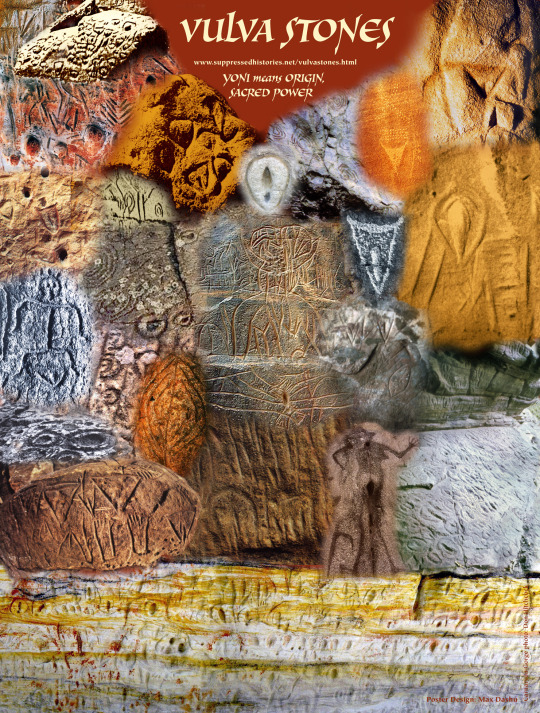
Vulva Stones poster
Petroglyphs of vulvas are engraved into rock walls, caves, and boulders all over the world. They date to the Paleolithic and into modern times. Some are deeply grooved into the stone from repeated tracings or from grinding out rock dust for conception, healing, rainmaking, and other ritual uses.
72 notes
·
View notes
